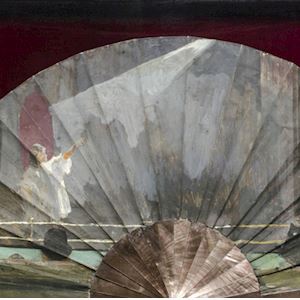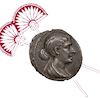
12. FINE ARTISTS
The works displayed between the two windows are by fine artists, as opposed to artists who have made fan painting their specialism. To explain the involvement of fine artists within the story of fan-painting, we should look Eastward, toward Japan. Following a sustained period of isolation, Japan was forcibly reopened in the 1850s. Suddenly Europe was flooded with Japanese prints, sculpture, lacquerware and, of course, fans. Inspired by Japanese aesthetics, several prominent artists including Degas, Toulouse Lautrec and Gauguin began experimenting with fan painting, recognising in this unique format, a creative challenge which required a different approach quite unlike that of the rectangular canvases which they usually painted. The impressionists conjured compositions unlike any seen before on fans with subjects appearing to float freely, moving beyond the boundaries of the arc in a manner reminiscent of Japanese fan painting. In the 20th century, artists continued to engage, albeit to a lesser extent, with the discipline of fan painting. In Britain, George Sheringham and Charles Condor produced designs for fans and other key figures in modern art – Miró, Dali and Kokoschka – painted fans during their lifetime.
To hear the Curator description of the fan painted by Walter Sickert,press A. Then please go to room two.
A. Walter Sickert, notorious for his impressionistic portraits of London’s ‘working’ women, painted this fan for fellow-artist and friend, Florence Pasch. Entitled ‘Little Dot Hetherington at The Old Bedford Theatre’, the work is based on an earlier oil painting forming part of the celebrated ‘Old Bedford’ series of sketches, lithographs, etchings and paintings. This is the only known fan attributed to Sickert. In contrast to the studied approach of the professional fan painter, here the paint is applied to the mount in a spontaneous manner, the colour palette complimenting the smoky mother of pearl sticks upon which the fan is mounted. Rendered in loose, expressive brushwork Sickert cleverly evokes the gilded, smoke-filled arena of the Victorian Music Hall. The viewer is drawn instinctively toward the ethereal figure in the centre of the fan, identified as Little Dot Hetherington, a young, jobbing actress, possibly of creole descent. Sickert places her centre stage; her adolescent form spot lit, an outstretched arm pointing upward alluding to the popular music hall song, The Boy I Love Is Up in the Gallery.


The Fan Museum
The Fan Museum is the UK's only organisation of its kind, devoted entirely to the subject of fans and craft of fan making. Housed in two beautifully restored Georgian period townhouses, its collections number more than 7,000 objects dating from the 12th century to present day.
